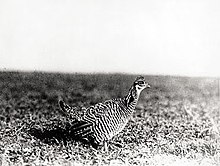| Heath hen | |
|---|---|

| |
| Live male specimen photographed c. 1909 | |
| Scientific classification | |
| Domain: | Eukaryota |
| Kingdom: | Animalia |
| Phylum: | Chordata |
| Class: | Aves |
| Order: | Galliformes |
| Family: | Phasianidae |
| Genus: | Tympanuchus |
| Species: | |
| Subspecies: | †T. c. cupido
|
| Trinomial name | |
| †Tympanuchus cupido cupido | |
The heath hen (Tympanuchus cupido cupido) is an extinct subspecies of the greater prairie chicken (Tympanuchus cupido), a large North American bird in the grouse family. It became extinct in 1932.
Heath hens lived in the scrubby heathland barrens of coastal North America from southernmost New Hampshire to northern Virginia in historical times. The other subspecies of prairie chickens inhabited prairies from Texas north to Indiana and the Dakotas (and earlier in mid-southern Canada).
Heath hens were extremely common in their habitat during colonial times; because of this, along with being a gallinaceous bird, they were hunted by settlers extensively for food. It is speculated that the Pilgrims' first Thanksgiving dinner featured heath hens and not wild turkey.[3] By the late 18th century, the heath hen had a reputation as poor man's food for being so cheap and plentiful; somewhat earlier, Thomas L. Winthrop had reported that they lived on the Boston Common (presumably when it was still used to graze cows and other agricultural activities), and that servants would sometimes bargain with a new employer to not be given heath hen for food more often than two or three days a week.[4]
- ^ "Tympanuchus cupido cupido - Heath Hen". NatureServe. 5 February 2021.
- ^ BirdLife International (2020). "Tympanuchus cupido". IUCN Red List of Threatened Species. 2020. Retrieved 10 December 2020.
- ^ Shuchat, Shimon. "The Original "Thanksgiving Turkey" is Now Extinct". In Defense Of Animals. Retrieved 10 August 2023.
- ^ Thompson, Daniel Q.; Ralph H. Smith (1971). "The Forest Primeval in the Northeast – A Great Myth?". Proceedings Annual Tall Timbers Fire Ecology Conference. 10: 263–4.

